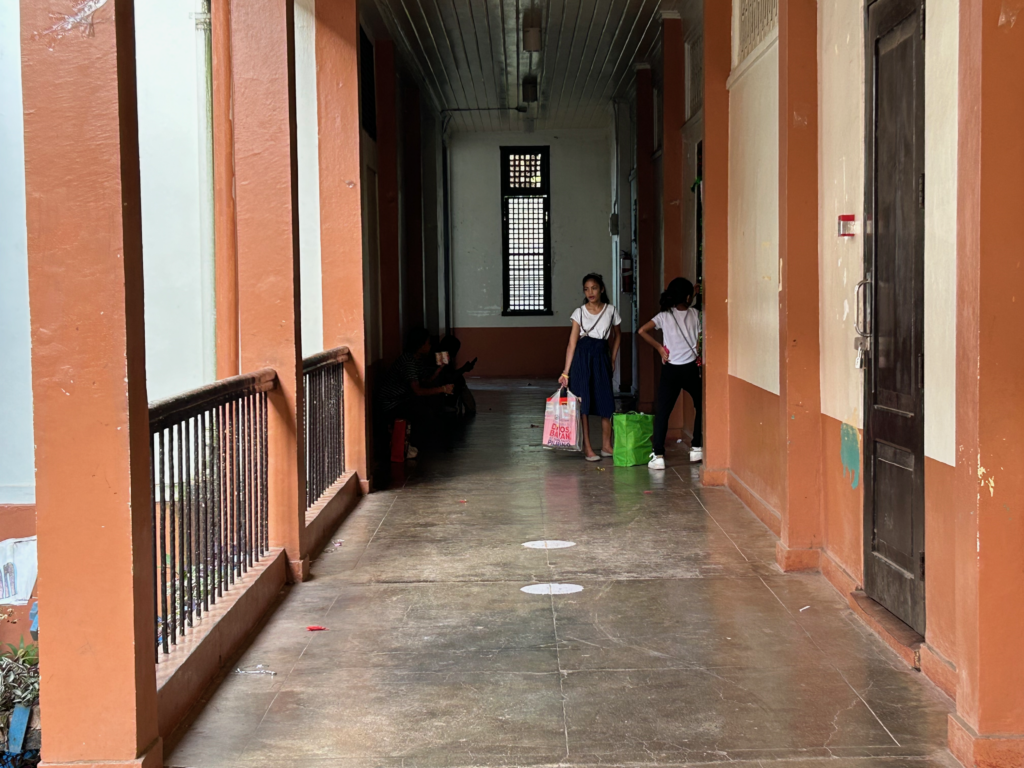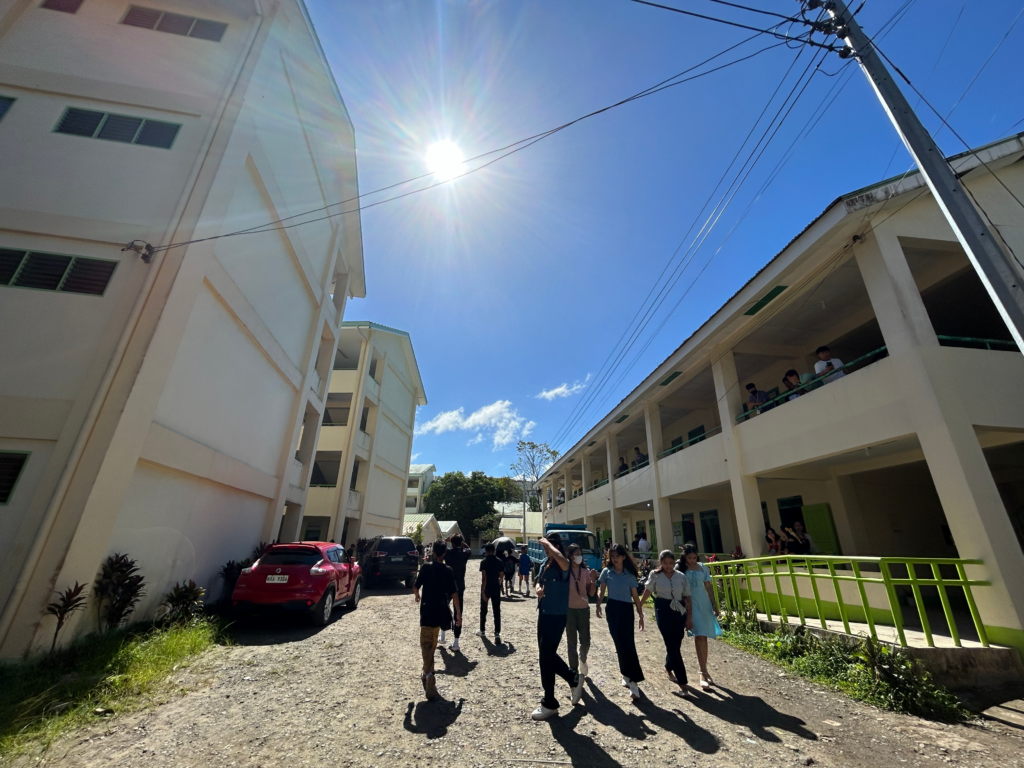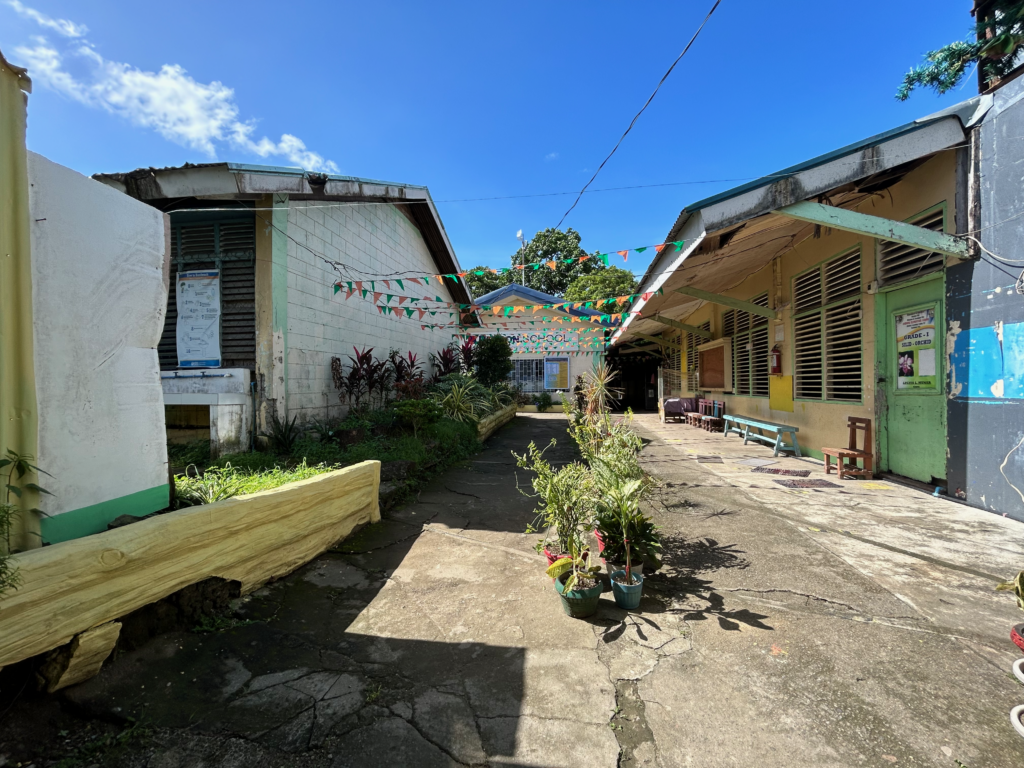This is the hallway leading to the inner classrooms of the Gabaldon building in Leyte National High School in Tacloban City, Leyte. It is considered the campus’ oldest surviving structure. In the summer of 2023, hundreds of students from here were sent to the clinic, complaining of headaches and hyperventilation due to the extreme heat. | Photo by Morexette Marie Erram
(Part 1 of 2)
CEBU CITY, Philippines — The decades-old Gabaldon building of Leyte National High School in Tacloban City has narrow hallways, high and dark ceilings, and overcrowded classrooms.
On hot and humid days, the rooms can feel stuffy and suffocating, prompting students like Dwight Lebrea, a 17-year-old Grade 12 student, to find ways to get some air, even if it meant going outside of the classroom.
“I feel like amo mao pinakamapaso na room,” Lebrea said. (I feel like our room was the hottest.)
From March to May 2023, hundreds of students from Leyte National High School, mostly those having classes in the Gabaldon building, were rushed to the school clinic due to intense headaches, hyperventilation, and asthma from the extreme heat.
For the first time ever, the school had to suspend face-to-face classes for two weeks due to heat.
This was not an isolated case.
A months-long analysis by Cebu Daily News Digital (CDN Digital) showed that students and teachers from over a thousand schools in the Philippines, including outside heavily congested Metro Manila, reported suffering from unbearable heat during the summer of 2023.
Poorer students suffer more and pay the price academically, as conditions are exacerbated by the longstanding problems of the country’s education system.

The outer hallway of the Gabaldon Building in Leyte National High School, Tacloban City. | Photo by Morexette Marie Erram
CDN Digital obtained exclusive access to a nationwide online survey of over 11,000 teachers conducted by the progressive organization Alliance of Concerned Teachers (ACT) in March 2023.
Nearly 9 out of 10 teachers surveyed said they and their students could not focus on lessons due to intolerable heat in classrooms. Many said the summer heat triggered existing medical conditions of teachers and students alike and that students missed classes due to insufferable heat.
Used to cancel classes due to typhoons, many schools had to revert to pandemic-era blended learning as a stop-gap measure to protect teachers and students from the heat.
“The hot environment during summer is no longer conducive for learning, especially for large classrooms with 70 to 80 students,” said Rep. France Castro of the Alliance of Concerned Teachers (ACT) partylist. “They (students) can no longer cope with the heat and (this) defeats the purpose of going to schools.”
After incessant calls from schools, students, and parents, the Department of Education in February decided to return, albeit slowly, to the old academic calendar, which they believed could help solve the heat problems schools experienced during the summer.
Experts, however, said the Philippine government must do more than just shift to the previous school calendar. They called for an increase in funding for education to include upgraded facilities, resilient infrastructure, and climate change adaptation.
The Philippines changed its academic calendar in 2014, moving the start of classes from June to somewhere between late August and September.
Since then, classes have been held during the hot, summer months from March to May. The move, which was meant to align the country’s school year with that of Western countries, was ironically done to avoid the typhoon season.
At the time of the shift, the average annual temperature in the country was 26.6 degrees Celsius, data from the United Nations Environment Programme (UNEP) and GRID-Geneva showed. But annual temperatures have since increased to 27.1 in 2021.
In fact, the Philippines has become warmer over the past four decades. Since 1970, the country’s annual average temperature has increased by about 0.6 degrees Celsius, according to the same data from UNEP and GRID-Geneva.
Scientists around the world said 2023 was the hottest year ever recorded, with the Philippines not spared from the extreme heat levels.
It was in 2023 when, for the first time in recent history, a large number of Philippine schools canceled face-to-face classes, and resorted to other modes of learning, due to unbearable heat during summer.
In Leyte National High School, over 1,500 students were rushed to the clinic due to heat-related illnesses. “In a day, that’s like around 10 to 20 children [had] to go to the clinic,” said Bernie Jude Lamograr, the school’s assistant principal.
Wilmonina Bering, a principal at a Mandaue City private school, which also canceled in-person classes, said last summer’s heat was “extremely unusual.”
Bering recalled having mirage-like and blurred visions whenever she looked at the streets, buildings, and houses around the school.
“You know it’s too hot outside because you start seeing waves. And sometimes they’re quite painful,” she described in Cebuano.
The 70-year-old principal also rarely experienced headaches. But at that time, she started having them, which she believed might have been triggered by the extreme heat.
It was also last year when the country recorded its highest heat index temperature yet.
Heat Index, often defined as the ‘apparent temperature felt by the human body’, is derived from measuring relative humidity and air temperature.
The municipality of Aparri in Cagayan province on July 5, 2023, had the highest heat index ever recorded in the Philippines, based on Pagasa’s historical data for the year. Aparri’s heat index reached a scorching 67 degrees Celsius, even hotter than the country’s previous record of 55 degrees, classified by Pagasa as extremely dangerous, in 2022.
Such high heat indices could cause heat stress and heat stroke, as even a heat index of 27 degrees can already result in fatigue and heat cramps.
With heat index temperatures of over 32 degrees Celsius, people should not stay under the sun beyond 20 minutes, said Pagasa Visayas chief Alfredo Quiblat Jr.
People living in Metro Manila are at higher risk of suffering from heat-related illnesses and stress than those outside of the region, according to a 2018 study that ranked 139 cities in the Philippines based on their Heat Health Risk Index (HHRI).
The HHRI measures a city’s risk of heat-related illnesses. The higher a city’s score is, the higher the likelihood that its residents will experience heat-related illnesses.
The capital Manila has the highest HHRI, which means its residents have a very high risk of experiencing heat stress that can negatively impact their health. But cities far from Manila have not been spared and also greatly suffered from intolerable heat last year.
It was like the pandemic all over again for schools that suffered the consequences of extreme heat in 2023.
CDN analysis showed that more than a thousand schools nationwide canceled in-person classes between March to May last year due to heat, with many opting to implement remote learning instead.
When heat temperatures reached dangerous levels, the Department of Education (DepEd) allowed schools to use alternative modes of learning – a move first introduced during the Covid-19 pandemic.
They cited as basis DepEd Memorandum No. 37, an order issued in 2022 that sets the guidelines on class cancellations or suspensions in case of natural disasters, power interruptions, and other calamities.
The same ACT survey showed that around 7 out of 10 respondents complained of unbearable heat when teaching during summer last year.
In Visayas, particularly in the provinces of Cebu, Leyte, and Eastern Samar, students and teachers struggled to cope with the unbearable heat.
Leyte and Eastern Samar are part of Eastern Visayas, the region that had the most number of cancellations last summer based on CDN’s collation of media reports.
Leyte National High School, the biggest public school in the entire region with over 8,000 students, was among those that canceled classes.

Students in Leyte National High School are in a festive mood in December 2023 as they look forward to having their Christmas parties despite the heat. | Photo by Morexette Marie Erram
Last summer, Tacloban City recorded an average heat index of 38.4 degrees – classified under ‘extreme caution’ level – which was 1.4 degrees higher than the same period in 2022.
Bernie Jude Lamograr, the school’s assistant principal and information officer, told CDN it was their first time to suspend face-to-face classes because of the hot and humid weather. In the past, usual reasons for cancellations or suspensions were heavy rains, floods, and earthquakes.
Initially, he said the school was hesitant to revert to modular classes, citing its negative impact on children’s education during the Covid-19 pandemic.
Edsyl Colico, who has been teaching in the school for over two decades, said students’ learning during the pandemic was not really “full” or complete.
“Normally yung mga bata basta naa sa bahay iba kasi yung focus nila… Hindi ka makakamonitor sa kanila. Hindi naman sila macocompel na gawin to whole day or tapusin to kasi andun naman sila sa bahay hindi ka naman nandun,” Colico said.
(Normally, kids cannot focus when they’re just in the house. We teachers cannot even monitor them. They also cannot be compelled to do school work the whole day because they’re in the house, we’re not there.)
In the end, the school had no choice as thousands of students were directly affected.
Many of these students, whose classes were held at the Gabaldon building, complained of headaches, hyperventilation, and asthma. A few teachers, who have pre-existing conditions, also complained of heat exhaustion, according to school nurse Nancy Britania.
Lebrea, who was a grade 11 student then, nearly fainted while attending a symposium in the school gymnasium in March 2023.
“I had to ask for assistance from my friend because I really couldn’t stand on my own. I felt that I was about to fall,” he said. “I could not breathe.”
During that summer, Lebrea said he visited the clinic thrice.
Calico said her other students also struggled to cope with the heat, with many getting sick and skipping school.
Asthma was among the top common illnesses observed among students when they go to school during the summertime, the same survey from ACT showed.
Teachers also said many of their students failed to attend classes.
The heat affected not only the students’ health but also their productivity. Grade 12 student Anthony Egot, 17, said he found it difficult to focus in school because of the heat.
Last summer, Egot had to attend classes at the school’s campus in Barangay Anibong, a coastal village in the northern side of Tacloban City. Anibong is where the infamous M/V Eva Jocelyn, one of the large cargo vessels pushed inland by Super Typhoon Yolanda (Haiyan) in 2013, can be found.

The school buildings inside the Anibong campus of Leyte National High School, which also served as Anibong Elementary School in Tacloban City, Leyte | Photo by Morexette Marie Erram
Similar to the rooms in the Gabaldon building, those in the Anibong campus were suffocating.
“I experienced headaches. I was sweating profusely, and usually, it would be hard to focus on the lessons because you have to constantly wipe the sweat dripping from your forehead,” Egot said.
In the afternoons, the searing heat from the sun would beat down on the corrugated steel roofs of nearby buildings and then get reflected onto the classrooms in Anibong. To protect themselves, students like Egot had to close the door, which was not entirely helpful as it blocked the entry of outside air.
It didn’t help that the campus was meant for grade school and junior high students, Egot said. Senior high school students like him felt that the classrooms were too small. (To be continued)
Reporting for this story was supported by the Environmental Data Journalism Academy – a program of Internews’ Earth Journalism Network and Thibi.
Heat index data was acquired from the Philippine Atmospheric Geophysical and Astronomical Services Administration (Pagasa), covering the period from January 2022 to July 2023.
Missing data due to technical errors at weather stations (encoded by Pagasa using the negative value -999) were excluded from our analysis. A complete list of the steps undertaken in scraping, cleaning, and analyzing the heat index data can be found on the Data Diary sheet of the DataDoc on Heat Index.
We also used rankings of the Heat-Health Risk Index (HHRI) from the study by Ronald Estoque, et. al, published in Nature Communications, which are available online.
Other datasets included in this story are the online survey by the Alliance of Concerned Teachers (ACT) in March 2023 about teaching experiences during hot and humid days. As to the number of schools that canceled in-person classes due to extreme heat in the summer of 2023, we used Google Advanced Search to find press clippings and reports pertaining to this.
DepEd announces gradual return to old school calendar starting SY 2024-2025